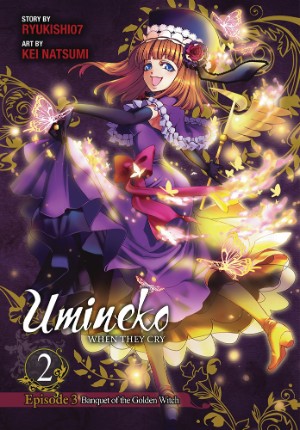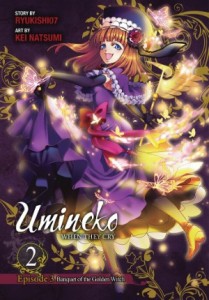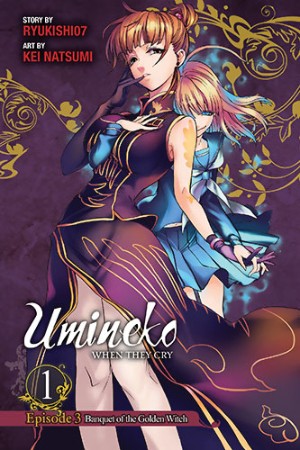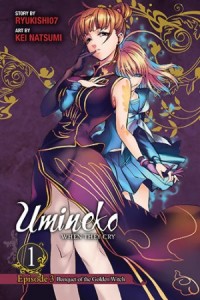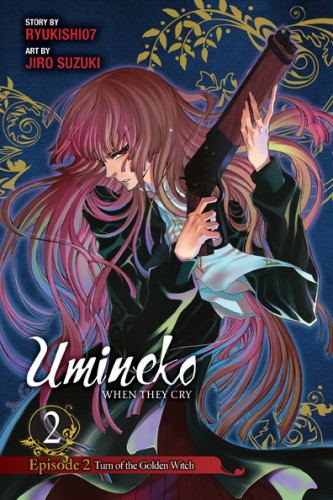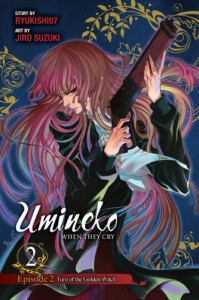Story by Ryukishi07; Art by Kei Natsumi. Released in Japan in two and 1/2 separate volumes as “Umineko no Naku Koro ni: Banquet of the Golden Witch” by Square Enix, serialized in the magazine Gangan Joker. Released in North America by Yen Press.
In general, I find that the Umineko manga does a bang-up job of adapting the original source. It can’t possibly have all the verbiage that the visual novels have, but it usually manages to include all the important points (something the anime adaptation was very good at avoiding), and it plays fair with the reader in regards to the mystery (something the anime didn’t even bother to try). Where the manga can truly stand up is when it dramatizes those moments in the VN where you really wish you could see more than just sprites on a screen, where you want some action and heartbreak.
Say what you will about Kei Natsumi’s love of exaggerated faces twisted to the extreme (Beatrice and Virgilia in the Golden Land comes to mind), she’s very good at laying out a page. There are lots of two-page spreads here designed to rivet the reader and keep them on the edge of their seats, the best of which is the moment when the fourth wall shatters. The last few Umineko ‘worlds’ have involved a meta world where Battler and Beatrice debate how things are being carried out while, on the island, the murders actually occur. The same thing is going on here, only Eva-Beatrice has ‘hijacked’ Beatrice’s game and is going around merrily torturing everyone.
Beatrice, at a low ebb after being yelled at by Battler for being uncaring and cruel, has been doing her best to stop the worst of these excesses, and when that fails she just straight up helps George and Jessica get a final moment with their loved ones, even at the cost of her life. It’s quite a character building moment for the Endless Witch, and Battler knows it. (Most of the shipping that exists in fandom started with this arc.) So, in the meta world, Beatrice asks if she’s redeemed herself enough to be Battler’s opponent. He notes she has, but that he’s not her opponent in this case… then reaches out, smashes into the island world, and grabs Eva-Beatrice by the scruff of her neck and drags her to him. It is *the* most badass moment in this volume, and beautifully handled.
(By the way, for those who enjoy being spoiled, Page 516 makes it clear that Kei Natsumi knows what’s really going on.)
Meanwhile, it becomes clear through most of this volume that Eva-Beatrice = Eva Ushiromiya, using the ‘witch’ identity to help commit murder. Why? DID YOU SEE ALL THAT GOLD? Some fans have trouble with ‘all that money’ as a motivating factor, to them, I recommend Higurashi, which is a lot more idealistic than this series. That said, some of the murders clearly are NOT the work of Eva, as her witch self points out to Battler – Eva couldn’t have killed Nanjo. In fact, none of them could have. So who did? Beatrice? Well, if Eva-Beatrice was Eva, then who is our Beatrice?
In the end, Battler (though he has improved greatly in his analysis) can’t get past this, and Beatrice sacrifices herself in order to stop Eva-Beatrice from winning the game. Thus they both end up in the Golden Land, which is essentially heaven. And it really points out all the difficulties with an idealized heaven that many people have if they look at it closely. In particular, Natsuhi and Eva hugging each other while despairing over their offspring marrying the servants is so horribly WRONG in every way you almost recoil at the change in their personalities. And sure enough, the Golden Land *is* false, a trap designed to make Battler accept witches. (How much Beatrice actually wants to go through with this trap is perhaps apparent in her faces right before she starts to cackle, which show someone desperately sad.)
Luckily, we have Ange coming to the rescue. Ignored in other arcs because she stayed home with a cold, almost forgotten by readers, Ange is older now and ready to kick Battler’s ass. And Beatrice’s as well, but most of this seems driven by a sense of jealousy and being left behind, which makes perfect sense. We do see the Ange of 1998 interacting with a dying Eva (who survived!), and she is at a point where she is the perfect pawn for Bernkastel to bring in to stop Beatrice. Of course, one wonders how much Bern is on anyone’s side…
By the end of this volume, I think even the most unspoiled should have a pretty good idea about the concept of Beatrice, if not the actual identity. And, just as Higurashi abandoned Keiichi in its 4th arc to focus on a new protagonist, so Umineko does the same, with Ange driving much of the next arc. Of course, that arc brings us full circle. At the start of this review, I raved about what a great manga adaptation can add to the source. With Alliance of the Golden Witch, we’ll find out what happens when a manga adaptation adds things you REALLY don’t want added to the source.
